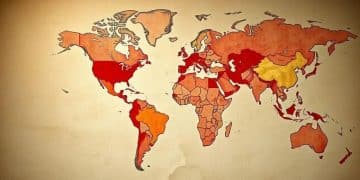Market outlook analysis: Bessent shares insights on trade

Market outlook analysis highlights the impact of Powell’s policies on the dollar, Argentina’s economic challenges, and future predictions, emphasizing the importance of staying informed for investment decisions.
Market outlook analysis: Have you ever wondered how global trade dynamics impact your investments? Bessent’s insights shed light on key factors that are shaping the market today.
Understanding the current trade landscape
Understanding the current trade landscape is essential to grasp the dynamics of global economics. Various factors shape it, including government policies, market demands, and international relations.
In recent times, trade disputes and tariffs have significantly impacted economies worldwide. As nations strive for balancing their exports and imports, it’s vital to analyze key aspects of this landscape.
Key Factors Influencing Trade
Several elements play a pivotal role in determining the flow of trade:
- Government Regulations: Tariffs and trade agreements shape how easily goods move across borders.
- Economic Indicators: Inflation rates, employment levels, and consumer demand directly affect trade viability.
- Technological Advancements: Innovations in shipping and logistics facilitate faster and more efficient trade.
Furthermore, political stability in a region fosters a favorable trade environment. Countries with strong diplomatic relations often enjoy better trading conditions, leading to more robust economic growth. Conversely, uncertainty, such as in the case of disputes, can cause markets to fluctuate.
Global Market Trends
Understanding trends in the current trade landscape requires deep analysis of market directions. Recently, there has been a shift towards sustainable practices. Companies are increasingly conscious of their supply chains and the impact on the environment.
Moreover, consumer preferences are evolving. More buyers are seeking out ethically sourced products, pushing businesses to adapt their strategies. In turn, this trend promotes fair trade practices and enhances global cooperation among companies aiming for sustainability.
As we delve deeper into how global markets function, it’s clear that staying updated with trade policies is crucial. Changes in leadership can usher in new regulations that could either enhance or hinder trade operations.
Impact of Powell’s policies on the dollar

The impact of Powell’s policies on the dollar is significant and multifaceted. As the Chair of the Federal Reserve, Jerome Powell’s decisions directly affect monetary policy and, consequently, the value of the U.S. dollar.
Changes in interest rates, for example, can either strengthen or weaken the dollar. When interest rates rise, the dollar typically strengthens. This is because higher rates offer better returns on investments denominated in dollars, attracting foreign capital.
Key Policy Decisions
Powell’s approach to managing inflation plays a crucial role in determining the dollar’s strength.
- Interest Rate Adjustments: Frequent changes influence investor confidence and market stability.
- Quantitative Easing: This strategy involves increasing money supply, which can dilute the dollar’s value.
- Forward Guidance: Communicating future policy intentions helps stabilize financial markets and set expectations.
Moreover, external factors like global economic conditions also affect how effective Powell’s policies are on the dollar’s value. During times of uncertainty, a strong dollar may be seen as a safe haven for investors. Conversely, economic downturns can lead to a depreciation of the dollar despite Powell’s best efforts.
Market Reactions
The market reacts quickly to Powell’s announcements. An unexpected rate hike might lead to a sudden surge in the dollar’s value, while a dovish stance could cause the dollar to decline.
Traders closely monitor the Federal Reserve’s statements and meeting minutes, as they can provide insight into future monetary policy directions. Understanding Powell’s perspective can help investors make informed decisions about currency trading.
Argentina’s economic challenges and opportunities
Argentina’s economic challenges and opportunities are complex and deserve careful examination. The country has faced significant hurdles, but there are also areas where potential growth exists.
High inflation and rising debt levels are two critical issues that impact Argentina’s economy. When inflation rates soar, purchasing power declines, making it difficult for citizens to afford basic necessities.
Key Economic Challenges
Several factors contribute to the challenging economic landscape:
- Inflation: Persistent inflation has plagued Argentina for years, eroding savings and income.
- Debt Crisis: High levels of public debt complicate the government’s ability to implement effective policies.
- Currency Fluctuations: The peso’s volatility affects international trade and investment.
Despite these challenges, Argentina has unique opportunities that can drive economic transformation. For instance, the country’s rich natural resources and agricultural output provide a solid foundation for growth.
Emerging Opportunities
Argentina’s agricultural sector, particularly in soybeans and beef, continues to be a significant contributor to exports. Fostering innovations and sustainable practices within this sector can enhance its competitiveness globally.
Furthermore, tourism shows potential for recovery post-pandemic. With diverse landscapes and rich culture, attracting international visitors can boost local economies.
By addressing its challenges head-on and leveraging available opportunities, Argentina can work toward stabilizing its economy and fostering long-term growth.
Future predictions in global markets

Future predictions in global markets are essential for investors and businesses alike. As we look ahead, various factors shape the economic landscape, influencing market trends.
Economic indicators signal potential changes. For instance, if economic growth continues, one can expect stock markets to respond positively. Conversely, signs of recession may prompt caution among investors.
Key Trends to Watch
Several significant trends may impact global markets in the coming years:
- Technological Advancements: The rise of AI and automation will reshape industries and create new investment opportunities.
- Climate Change Initiatives: Companies focusing on sustainable practices may attract environmentally conscious investors.
- Geopolitical Events: Conflicts and trade agreements can alter investor confidence and market dynamics.
As we predict future market movements, understanding these trends can aid in making informed decisions. Investors should remain vigilant about how global economic policies unfold.
Emerging Markets
Investing in emerging markets could offer higher returns as they often experience faster growth. Countries like India and Brazil demonstrate vast potential due to their young populations and increasing tech adoption.
However, it’s vital to consider the risks involved, including political instability and economic volatility. Careful analysis of these markets can foster strategic opportunities for future growth.
In summary, understanding the current market outlook can be crucial for making informed investments. From Powell’s policies on the dollar to the economic challenges in Argentina, each element plays a role in shaping future trends. By staying aware of key developments and emerging opportunities, investors can better navigate the complexities of global markets.
FAQ – Frequently Asked Questions about Market Outlook Analysis
What factors influence the strength of the dollar?
The strength of the dollar is influenced by interest rates, inflation, economic growth, and government policies.
How does Powell’s monetary policy affect investors?
Powell’s monetary policy can impact interest rates, which directly affect investment returns and market stability.
What are Argentina’s current economic challenges?
Argentina faces high inflation, rising debt levels, and currency volatility that hinder economic growth.
What future trends should investors watch for?
Investors should monitor technological advancements, sustainability efforts, and geopolitical events that may shape the market.






